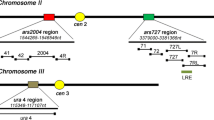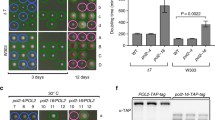Summary
Previous studies have indicated that DNA bending is a general structural feature of sequences (ARSs) from cellular DNAs of yeasts and nuclear and mitochondrial genomic DNAs of other eukaryotes that are capable of autonomous replication in Saccharomyces cerevisiae. Here we showed that bending activity is also tightly associated with S. cerevisiae ARS function of segments cloned from mitochondrial linear DNA plasmids of the basidiomycetes Pleurotus ostreatus and Lentinus edodes. Two plasmids, designated pLPO2-like (9.4 kb), and pLPO3 (6.6 kb) were isolated from a strain of P. ostreatus. A 1029 by fragment with high-level ARS activity was cloned from pLPO3 and it contained one ARS consensus sequence (A/T)TTTAT(A/G)TTT(A/T) indispensable for activity and seven dispersed ARS consensus-like (10/11 match) sequences. A discrete bent DNA region was found to lie around 500 by upstream from the ARS consensus sequence (T-rich strand). Removal of the bent DNA region impaired ARS function. DNA bending was also implicated in the ARS function associated with a 1430 by fragment containing three consecutive ARS consensus sequences which had been cloned from the L. edodes plasmid pLLE1 (11.0 kb): the three consecutive ARSs responsible for high-level ARS function occurred in, and immediately adjacent to, a bent DNA region. A clear difference exists between the two plasmid-derived ARS fragments with respect to the distance between the bent DNA region and the ARS consensus sequence(s).
Similar content being viewed by others
References
Birnboim HC, Doly J (1979) A rapid alkaline extraction procedure for screening recombinant plasmid DNA. Nucleic Acids Res 7:1513–1523
Biswas SB, Biswas EE (1990) ARS binding factor I of the yeast Saccharomyces cerevisiae binds to sequences in telomeric and nontelomeric autonomously replicating sequences. Mol Cell Biol 10:810–815
Botstein D, Falco SC, Stewart SE, Brennan M, Scherer S, Stinchcomb DT, Struhl K, Davis RW (1979) Sterile host yeasts (SHY) A eukaryotic system of biological containment for recombinant DNA experiments. Gene 8:17–24
Boyer HW, Roulland-Dussoix D (1969) A complementation analysis of the restriction and modification of DNA in Escherichia coli. J Mol Biol 41:459–472
Broach JR, Li Y, Feldman J, Jayaram M, Abrahm J, Nasmyth K, Hicks J (1983) Localization and sequence analysis of yeast origins of DNA replication. Cold Spring Harbor Symp Quant Biol 47:1165–1173
Buchman AR, Kornberg RD (1990) A yeast ARS-binding protein activates transcription synergistically in combination with other weak activating factors. Mol Cell Biol 10:887–897
Cryer DR, Eccleshall R, Marmur J (1975) Isolation of yeast DNA. Methods Cell Biol 12:39–44
Davis RW, Botstein D, Roth JR (1980) A Manual for Genetic Engineering, Advanced Bacterial Genetics. Cold Spring Harbor Laboratory Press, Cold Spring Harbor, New York
Eckdahl TT, Anderson JN (1987) Computer modelling of DNA structures involved in chromosome maintenance. Nucleic Acids Res 15:8531–8545
Eckdahl TT, Anderson JN (1990) Conserved DNA structures in origins of replication. Nucleic Acids Res 18:1609–1612
Feinberg AP, Vogelstein B (1983) A technique for radiolabelling DNA restriction endonuclease fragments to high specific activity. Anal Biochem 132:6–13
Hanahan D (1983) Studies on transformation of Escherichia coli with plasmids. J Mol Biol 166:557–580
Hinnen A, Hicks JB, Fink GR (1978) Transformation of yeast. Proc Natl Acad Sci USA 75:1929–1933
Hofmann JF-X, Gasser SM (1991) Identification and purification of a protein that binds the yeast ARS consensus sequence. Cell 64:951–960
Katayose Y, Shishido K, Ohmasa M (1986) Cloning of Lentinus edodes mitochondrial DNA fragment capable of autonomous replication in Saccharomyces cerevisiae. Biochem Biophys Res Commun 138:1110–1115
Katayose Y, Kajiwara S, Shishido K (1990) The basidiomycete Lentinus edodes linear mitochondrial DNA plasmid contains a segment exhibiting a high autonomously replicating sequence activity in Saccharomyces cerevisiae. Nucleic Acids Res 18:1395–1400
Linn SM (1982) Tabulation of some well-characterized enzymes with deoxyribonuclease activity. In: Linn SM, Roberts RJ (eds) Nucleases. Cold Spring Harbor Laboratory Press, Cold Spring Harbor, New York, pp 341–357
Maniatis T, Fritsch EF, Sambrook J (1982) Molecular cloning: A laboratory manual. Cold Spring Harbor Laboratory Press, Cold Spring Harbor, New York
Messing J (1983) New M13 vectors for cloning. Methods Enzymol 101:20–78
Murray MG, Thompson WF (1980) Rapid isolation of high molecular weight plant DNA. Nucleic Acids Res 8:4321–4325
Reed KC, Mann DA (1985) Rapid transfer of DNA from agarose gels to nylon membranes. Nucleic Acids Res 13:7207–7221
Sakaguchi R, Shishido K (1988) Molecular cloning of a tetracycline-resistance determinant from Bacillus subtilis chromosomal DNA and its expression in Escherichia coli and B. subtilis. Biochim Biophys Acta 949:49–57
Sambrook J, Fritsch EF, Maniatis T (1989) Molecular cloning: A laboratory manual, 2nd edn. Cold Spring Harbor Laboratory Press, Cold Spring Harbor, New York
Sanger F, Nicklen S, Coulson AR (1977) DNA sequencing with cain-terminating inhibitors. Proc Natl Acad Sci USA 74:5463–5467
Schmidt AMA, Herterich SU, Krauss G (1991) A single-stranded DNA binding protein from S. cerevisiae specifically recognizes the T-rich strand of the core sequence of ARS elements and discriminates against mutant sequences. EMBO J 10:981–985
Sherman F, Fink GR, Hicks JB (1982) Methods in Yeast Genetics. Cold Spring Harbor Laboratory Press, Cold Spring Harbor, New York
Ulanovsky L, Trifonov EN (1987) Estimation of wedge components in curved DNA. Nature 326:720–722
Williams JS, Eckdahl TT, Anderson JN (1988) Bent DNA function as a replication enhancer in S. cerevisiae. Mol Cell Biol 8:2763–2769
Wu H, Crothers DM (1984) The locus of sequence-directed and protein-induced DNA bending. Nature 308:509–513
Yanisch-Perron C, Vieira J, Messing J (1985) Improved M13 phage cloning vectors and host strains: nucleotide sequences of the M13mpl8 and pUC19 vectors. Gene 33:103–119
Yui Y, Katayose Y, Shishido K (1988) Two linear plasmid-like DNA elements simultaneously maintained in Pleurotus ostreatus. Biochim Biophys Acta 951:53–60
Author information
Authors and Affiliations
Additional information
Communicated by C.P. Hollenberg
Rights and permissions
About this article
Cite this article
Nakajima, M., Sheikh, Q.I., Yamaoka, K. et al. Bending of DNA segments with Saccharomyces cerevisiae autonomously replicating sequence activity, isolated from basidiomycete mitochondrial linear plasmids. Molec. Gen. Genet. 237, 1–9 (1993). https://doi.org/10.1007/BF00282777
Received:
Accepted:
Issue Date:
DOI: https://doi.org/10.1007/BF00282777




